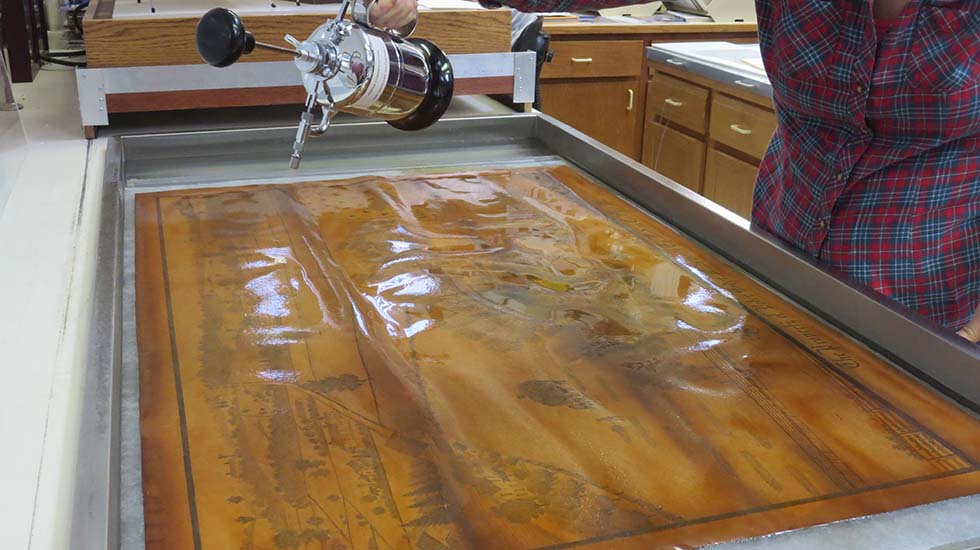Conserving Brader Drawings
WHY ARE THE PAPERS SO DARK
Ferdinand Brader’s heavy papers are prone to severe degradation and the formation of dark brown discolorations. Both are processes that accelerate as acid molecules form and continue to accumulate in the paper. The deterioration and darkening is exacerbated by contact with wood backings typical of 19th century framing methods and exposure to light and humidity.
Brader’s papers are believed to have become exceptionally dark and degraded because he was known to apply buttermilk to each finished drawing and buttermilk is quite acidic (pH 4.4-4.8). Indeed, there is visual evidence on some of his drawings of some material having been applied by brush.
Explained very simply and making leaps across a lot of more precise chemical descriptions, the problems of darkening and degradation have their principal source in the pulp used to make the papers and the sizings applied. Since the mid-19th century, pulp made from wood and other sources of cellulose bound by large and complex molecules called lignin quickly predominated over the much more stable and pure cellulose of cotton and linen. Briefly, the energy provided by light breaks down the lignin molecules (acid hydrolysis) into other molecules, producing a variety of acids and molecules with brown colors called chromophores. These acids produced, in the presence of light and humidity, further act to accelerate hydrolysis, producing more and more acids and darker colors in the paper. Light, humidity (moisture), contact with acidic wood and cardboard, and the accelerating accumulation of acids in these papers are destroying the drawings. Dark vertical stripes seen in Brader drawings correspond to the locations of vertical splits in original, thin wood backings. The slits admitted more oxygen and humidity – both acting to accelerate the degradation in these local areas.
Left untreated, the drawings by Ferdinand Brader will eventually disintegrate. Conserving Brader drawings not only improves the appearance, but also lengthens the life span of these important artworks.
WHAT CAN BE DONE?
The degradation of Ferdinand Brader’s papers can be halted and the dark discolorations partially removed by modern processes of aqueous deacification and light energy treatments performed by professional paper conservators. Most conservators nowadays have completed specialized training in such art conservation treatments in university graduate programs and the treatments are constantly being evaluated and improved by conservation scientists. Typical conservation treatments include successive day-long bathing of the papers on supports in water treated chemically to neutralize the acids and wash out many soluble acids. Chemical bleaching agents are not used and should not be used.
As many as five or six days of bathing and professional attention would be typical to optimally stabilize a Brader drawing. The deacidification process has a side benefit – the solubilization and removal of some of the dark chromophoric molecules. Additionally, much of any residual dark molecules can be destroyed by breaking them down with prolonged exposure to high energy light. This treatment that has been proven over the past 34 years by practitioners and scientists to have no damaging effects on any components of the paper except the dark chromophores so long as the paper is in the correct pH bath. The potentially damaging treatments for paper discoloration by chemical bleaching of the past have been replaced by such “light bank” treatments. McKay Lodge Conservation Laboratory has performed over a dozen Brader conservation treatments.
All this professional work is very time-consuming and expensive. What can one do to preserve a Brader drawing short of these measures?
These measures will slow the degradation to some limited extent only:
- Reframe, as necessary to remove acidic cardboards and wood from contact with the paper.
- Keep the drawing in low levels of artificial (incandescent), not daylight. It is additionally advised that framed drawings be glazed with ultraviolet light filtering glass or acrylic sheet.
- Keep the drawing in low humidity.

